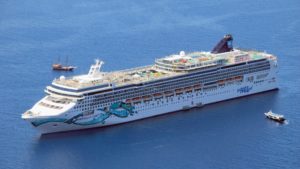Travel and leisure equities, including Norwegian Cruise Line (NYSE:NCLH), are ground zero for havoc wrought by the novel coronavirus. And NCLH proves as much with a first-quarter decline of more than 80%.

What makes the near-term outlook for NCLH stock murky is that relative to airlines, hotels and even casinos, cruises just aren’t essential elements of the U.S. economy. Yes, airlines are a troubled industry, one that’s needed two bailouts just this century. But air travel is still vital to the economy.
Same goes for hotels. Business and leisure travelers need somewhere to stay upon arriving at their destinations, and hotels are major job creators. Say what you want about casinos — certainly purveyors of vice — but the industry generates over $260 billion in annual economic impact while supporting 1.8 million jobs.
Those are big numbers, ones that underscore the importance of gaming. On the other hand, cruise operators pay little in taxes to federal and state governments. And while there are jobs involved — a point that should not be diminished — cruise operators just aren’t as important to the U.S. economy as the aforementioned industries.
Zeroing in on the Woes of NCLH Stock
Lack of importance isn’t the sole determinant in evaluating a consumer discretionary stock. After all, “discretionary” implies something isn’t essential. What’s infinitely more relevant is the ability of these companies to survive in an extended zero-revenue environment.
Some analysts are working under the premise that all cruises will be canceled through the end of the third quarter. Then, they predict an uptick in demand in the final three months of the year.
“While this might be a harsh analysis, we believe the mass hysteria around COVID-19 could impact cruise demand for an extended period,” said Stifel analyst Steven Wieczynski in a note to clients. “Under this dire situation, NCLH would have a funding shortfall (after six months of no operations) but the shortfall wouldn’t be overly material (~$0.5B) and we believe NCLH could arrange additional financing through their export credit agreements or other arrangements.”
Basically, Wieczynski thinks Norwegian should be able to avoid bankruptcy. However, that’s only the case as long as the no-revenue climate ends in six months or less.
So if Norwegian ships can hit the seas again by October, the company’s survival odds dramatically improve. Then, the company can assist by cutting spending.
Norwegian was planning about $900 million in non-essential capital spending this year, a figure that it can easily reduce by 70% to conserve capital.
Bottom Line on Norwegian Cruise Line
While it appears likely NCLH stock will survive, it is in the midst of a breathtaking decline. It flirted with $60 early this year and now resides just above $9. It may be tempting to nibble at a stock following a decline like that, but there are other factors to consider.
First, should Norwegian need to issue debt to stay afloat, it’ll be at rates favorable to creditors, not the company or equity investors. Second, there’s the matter of demand. Even when the pandemic is resolved, there’s no guarantee that travelers’ appetite for cruises will perfectly rebound.
Finally, NCLH stock is not expensive, but it may only warrant a mid-single-digit multiple based on the headwinds the industry faces. That multiple may imply value, but it doesn’t mean good value.
Todd Shriber has been an InvestorPlace contributor since 2014. As of this writing, he did not hold a position in any of the aforementioned securities.
